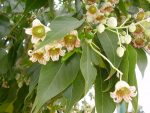 Commonly known as the kurrajong, this small to medium-sized evergreen tree is native to Australia where it grows in diverse habitats. It is member of the mallow family, Malveaceae, that also includes okra, cotton, chocolate and hollyhock. The trees grow 30-50′ tall and have a bottle like swelling at the base of their trunks which stores water. The ovate green leaves are up to 3″ long, may be simple or have 3-9 lobes, and shimmer in the breeze like those of quaking aspens. In late spring or early summer 3″ long clusters of male and female 1/2″ wide yellowish-white flowers appear on the same plant. They lack petals but the caylx forms bell shaped perianth that is reddish inside and sometimes has dark spots on the outside. Fertilized female flowers give way to a woody canoe-shaped dry seedpod that is 2-3″ long and can be a litter problem. Bottle tree is tolerant of drought and partial shade, and is suitable for windbreaks, screen, street tree, and shade tree in a xeriscape. The seedpods are attractive in dried arrangements. The genus name, Brachychiton, is from the Greek words brachys meaning short, and chiton meaning tunic, and refers to the loose seedcoat. The specific epithet, populneus, means similar to Populus, poplars, refering to the leaves.
Commonly known as the kurrajong, this small to medium-sized evergreen tree is native to Australia where it grows in diverse habitats. It is member of the mallow family, Malveaceae, that also includes okra, cotton, chocolate and hollyhock. The trees grow 30-50′ tall and have a bottle like swelling at the base of their trunks which stores water. The ovate green leaves are up to 3″ long, may be simple or have 3-9 lobes, and shimmer in the breeze like those of quaking aspens. In late spring or early summer 3″ long clusters of male and female 1/2″ wide yellowish-white flowers appear on the same plant. They lack petals but the caylx forms bell shaped perianth that is reddish inside and sometimes has dark spots on the outside. Fertilized female flowers give way to a woody canoe-shaped dry seedpod that is 2-3″ long and can be a litter problem. Bottle tree is tolerant of drought and partial shade, and is suitable for windbreaks, screen, street tree, and shade tree in a xeriscape. The seedpods are attractive in dried arrangements. The genus name, Brachychiton, is from the Greek words brachys meaning short, and chiton meaning tunic, and refers to the loose seedcoat. The specific epithet, populneus, means similar to Populus, poplars, refering to the leaves.
Type: Evergreen tree
Outstanding Feature: Drough tolerance
Form: Conical
Growth Rate: Rapid
Bloom: Clusters of small yellowish-white flowers in late spring to early summer
Size: 30-50′ H x 30′ W
Light: Full sun to partial shade
Soil: Average, medium moist to dry, well-drained
Hardiness: Zones 8-11
Care: Prune out broken or diseased branches in early spring. Clean up litter of seed pods in fall.
Pests and Diseases: Susceptible to shot hole borer, root rot.
Propagation: Seed, cuttings
Photo Credit: Wikipedia